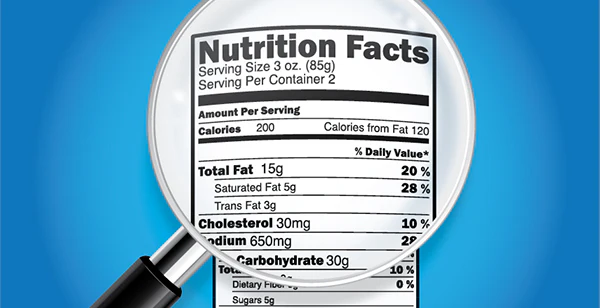Have you ever wondered what all those labels on your food packaging actually mean?
Understanding food labels is crucial for anyone trying to make healthier choices, particularly when managing weight. Food companies use clever marketing tricks to make their products appear healthier than they are. Phrases like “low fat,” “sugar-free,” and “all-natural” often mislead consumers, making it difficult to choose wisely. This blog will help you decode food labels, revealing what marketers don’t want you to know.
What Are the Most Common Misleading Terms on Food Labels?
When you’re trying to eat healthily, terms like “low fat,” “sugar-free,” and “organic” might sound appealing. However, these labels can be misleading. For instance:
- Low Fat: Products labelled “low fat” often compensate by adding extra sugar or artificial additives to improve the taste. The label may sound healthy, but the actual content could be counterproductive for your weight loss goals.
- Sugar-Free: This label often means that a product contains artificial sweeteners, which may have their own set of health concerns. Some sweeteners can trigger cravings or affect your gut microbiome.
- All-Natural: The term “natural” isn’t regulated in many countries, meaning it doesn’t necessarily indicate a healthier choice. For example, natural flavors can still be highly processed and contain a mixture of chemicals.
- Organic: While organic foods are grown without synthetic pesticides or fertilizers, the term does not automatically mean the food is low in calories, sugar, or fat. Organic cookies, chips, or sugary cereals can still lead to weight gain if consumed in excess.
These labels can be confusing, but understanding what they actually mean will help you make better decisions.
Why Should You Pay Attention to Serving Sizes?
One of the most overlooked sections on a food label is the serving size. Companies often list a small serving size to make their product appear healthier. For example, a juice bottle might list 100 calories per serving, but the bottle contains 2.5 servings. This means if you drink the entire bottle, you’re consuming 250 calories, not 100.
It’s essential to check the serving size and adjust your intake accordingly. If you’re eating more than one serving, you need to multiply all the nutritional values, including calories, sugar, fat, and sodium, by the number of servings consumed. Understanding this can prevent you from unknowingly over-consuming calories, which is critical for weight management.
How Can the Ingredient List Tell You What’s Really in Your Food?
The ingredient list is where the real story lies. Ingredients are listed in order of quantity, from highest to lowest. If sugar or high-fructose corn syrup is among the first three ingredients, the product is likely high in added sugars, even if it’s labelled “low fat” or “natural.” Also, look out for ingredients with different names that essentially mean sugar, such as dextrose, maltose, syrup, and fruit juice concentrate.
A long ingredient list filled with complex, unpronounceable names often indicates that a product is highly processed. Whole foods generally have shorter ingredient lists, making them healthier choices. Familiarize yourself with these ingredient names and their implications for your diet. You’ll soon be able to spot unhealthy products more easily.
Why Is Understanding Fat Content Crucial for Weight Management?
Not all fats are created equal, and understanding this is key to choosing healthier foods. Many products highlight their “low fat” or “fat-free” claims, but it’s crucial to differentiate between types of fat:
- Saturated Fats: Found in animal products and some processed foods, saturated fats can raise bad cholesterol levels. Aim to consume these in moderation.
- Trans Fats: Often found in fried foods and baked goods, trans fats are the worst kind of fat and can increase the risk of heart disease. Avoid these completely if possible.
- Unsaturated Fats: Found in nuts, seeds, avocados, and olive oil, unsaturated fats are heart-healthy and beneficial when consumed in moderation.
A good rule of thumb is to look for products that contain healthy fats while minimizing or eliminating trans and saturated fats. This helps in maintaining a balanced diet without sacrificing the fat needed for essential bodily functions.
What Does “No Added Sugars” Really Mean?
The label “no added sugars” is becoming increasingly popular as people become more health-conscious. However, this label doesn’t mean the product is sugar-free. It means no sugars were added during the processing, but it may still contain natural sugars, like those found in fruits or milk.
Moreover, some products use fruit juice concentrates or other natural sweeteners as a substitute for sugar, which can be just as calorically dense and affect blood sugar levels. The American Heart Association recommends no more than 24 grams (6 teaspoons) of added sugar per day for women and 36 grams (9 teaspoons) for men. Being aware of how much sugar you’re consuming from both added and natural sources is vital for weight management.
Why Should You Watch Out for Sodium Levels?
Sodium is another sneaky ingredient that often goes unnoticed. High sodium levels can lead to water retention, making you feel bloated and potentially raising your blood pressure. Many products marketed as “healthy” or “low-calorie” can still have high sodium levels to enhance flavor.
The FDA recommends no more than 2,300 milligrams of sodium per day, but most people consume far more. Processed foods, canned soups, and packaged snacks are often loaded with sodium. When reading labels, aim for foods that contain less than 5% of your daily value per serving to keep your sodium intake in check.
How Can You Use the % Daily Value (%DV) Wisely?
The % Daily Value (%DV) on food labels helps you understand how much a nutrient in a serving of food contributes to a daily diet. It is based on a 2,000-calorie daily intake, which might not align with everyone’s needs. However, it’s still a useful tool for understanding if a food is high or low in a particular nutrient:
- 5% DV or less is low: Aim for low %DV for saturated fat, cholesterol, and sodium.
- 20% DV or more is high: Aim for high %DV for fiber, vitamins, and minerals like calcium and iron.
Using %DV as a quick reference can help you balance your daily nutrient intake and ensure you’re getting what you need while avoiding what you don’t.
How Modest Medix Can Help You
At Modest Medix a Weight Management Clinic in Missssuga, our focus is on helping individuals achieve sustainable weight management through a holistic, evidence-based approach. Unlike programs that promise rapid weight loss or rely on extreme diets, Modest Medix emphasizes gradual, long-term changes that improve overall health and well-being. Our program combines nutritional counselling, behavioural coaching, and medical supervision to address the root causes of weight gain and support lasting lifestyle changes. With a dedicated team of healthcare professionals, we guide you through every step of your journey, helping you set realistic goals, develop healthy habits, and maintain motivation. Whether you’re dealing with weight-related health issues or simply want to improve your overall fitness, Modest Medix offers the support, tools, and resources needed to make meaningful and lasting changes.
Conclusion:
Modest Medix focuses on sustainable, evidence-based weight management, prioritizing long-term health over quick fixes. Our approach is personalized, supporting gradual changes tailored to your readiness. While not for those seeking immediate results, we offer valuable resources for those committed to lasting success. Choose Modest Medix for a balanced, realistic path to achieving your goals.
About the Author:
Dr. Saima Khan, MD, CCFP, IPM, dABOM, is an Interventional Pain Medicine Specialist and Diplomate of the American Board of Obesity Medicine. As an Acceptance and Commitment Therapy (ACT) Therapist, she specializes in guiding patients with obesity and chronic pain toward value-driven living and meaningful actions. Dr. Khan is passionate about offering realistic, enjoyable, and sustainable health solutions that address both the physical and psychological needs of her patients. Through her innovative approach at Modest Medix and commitment to holistic care, she inspires individuals to take charge of their well-being.










